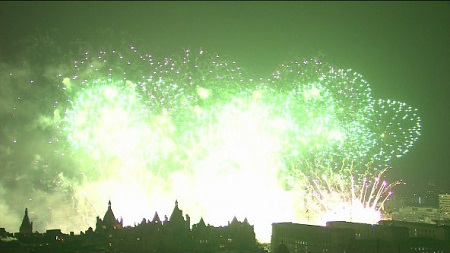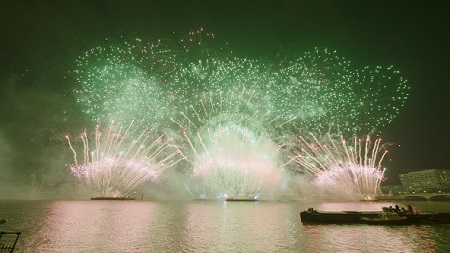HDR Video With Stephan Ukas-Bradley
ALEXANDRIA, VA. — Most of the video discussion lately has been about resolution, with lots of articles about 4K/UHD and related technology. However, resolution is far from the only quality that characterizes good images—color saturation and purity, as well as dynamic range play big roles in defining an excellent image.
With recent improvements in digital cameras has come the concept of high dynamic range photography. HDR technology can be used to take photos that show detail in both the bright and dark areas of the image, making more natural and interesting photos.
The BBC recently conducted a test of video HDR, using an Arri Amira cinematography camera to shoot one of the trickiest subjects for both photographers and videographers: fireworks. Stephan Ukas-Bradley is the director of strategic business development and technical marketing at Arri, and he took some time with Broadcast Engineering Extra to explain the significance of this test and the role of HDR video.
Stephan Ukas-Bradley, director of strategic business development and technical marketing at Arri BE Extra: What is "high dynamic range" and why should broadcasters and content producers be interested in it?

Ukas-Bradley: High Dynamic Range or Extended Dynamic Range is a set of techniques used in imaging and photography to reproduce a greater range of luminosity than possible using current standard technology. In still photography, these kind of images can be achieved by sequential exposures being "blended" to one image. In motion picture imaging, this is not desirable, because it would render motion artifacts when the subject or the camera is moving. Arri introduced a way of capturing the maximum dynamic range called "dual gain architecture." By providing two separate readout paths from each pixel with different amplification simultaneously, Arri Alexa and Amira cameras can achieve up to 14-plus stops of dynamic range.
HDR provides a more immersive and real-life viewing experience. With viewing habits changing rapidly by consumers watching content on their phones, tablets and computers, HDR is even more effective than higher resolution displays as there is also a perceived higher sharpness with higher contrast.
BE Extra: The BBC recently tested an Arri Amira camera by shooting some fireworks. The camera has 14-plus stops of dynamic range, which is about as high as it gets today. But is that as high as it can get? Can we expect future cameras with an even wider dynamic range? Is there a physical limit for dynamic range?
The professional video industry's #1 source for news, trends and product and tech information. Sign up below.
Ukas-Bradley: How much dynamic range can be captured by a sensor depends on various parameters. Arri made a cautious decision by using better pixels rather than more pixels on their custom sensor design. What this means is that employing larger pixels results in better signal/noise ratio, lower crosstalk, higher sensitivity and more dynamic range. In short, the larger the pixel, the more light it can capture and the lower the noise. With improved sensor technology and higher quantum efficiency, the dynamic range that sensors will be able to capture will increase. Will there be a limit? Hard to say, but there is certainly a limit of how many stops the human eye can capture (10-14 stops, approximately 22-24 stops with pupil opening and closing for different brightness regions).

A still of the video image without the HDR process (Photo courtesy of the BBC.)

A still of the video image using the HDR process (Photo courtesy of the BBC)
BE Extra: How much role does a lens play with respect to HDR video? What are one or two things to consider when acquiring a lens to support wide dynamic range?
Ukas-Bradley: The speed of the lens can be a factor when trying to capture more shadow detail. Personally I would prefer prime lenses over zooms, as they are traditionally faster and have a higher MTF.
BE Extra: What recording format was used for the BBC's test? Can you reasonably expect to get good HDR video performance using a compression codec such as HEVC?
Ukas-Bradley: The footage on the BBC test was recorded in ProRes 444, LogC. ProRes is a very good and efficient codec (12-bit, 330 Mbps at 30 fps) widely used in episodic television, commercials and even feature production. We are supporting all flavors of ProRes and collaborated with Apple on the newly introduced and even higher bit-rate ProRes XQ. In general, the bit depth of any codec could be a limiting factor to displaying HDR originated and graded material—anything lower than 10-bit would be insufficient in my opinion.
BE Extra: The Amira camera used for the BBC's test is a 4K/UHD device. Is this technology that can be effectively delivered in HD, or does it really need a UHD display and transmission chain to see the impact?
Ukas-Bradley: HDR is resolution-independent and we rendered some outstanding results using Alexa in ArriRaw, HD or 2K ProRes. In our opinion, dynamic range is an even more important factor than spatial resolution in creating a superior visual experience.
BE Extra: Is there anything else about acquiring HDR video content that our readers should know?
Ukas-Bradley: There are currently different approaches being offered for standardization by companies such as Dolby, BBC, Philips and Technicolor. We are currently monitoring all and try to be compliant with them. Alexa's and Amira's exposure latitude, highlight handling and color science already result in images beyond the capabilities of current display technologies, so we welcome the efforts of the above mentioned companies to tap into our technology's real potential.
Bob Kovacs is the former Technology Editor for TV Tech and editor of Government Video. He is a long-time video engineer and writer, who now works as a video producer for a government agency. In 2020, Kovacs won several awards as the editor and co-producer of the short film "Rendezvous."

